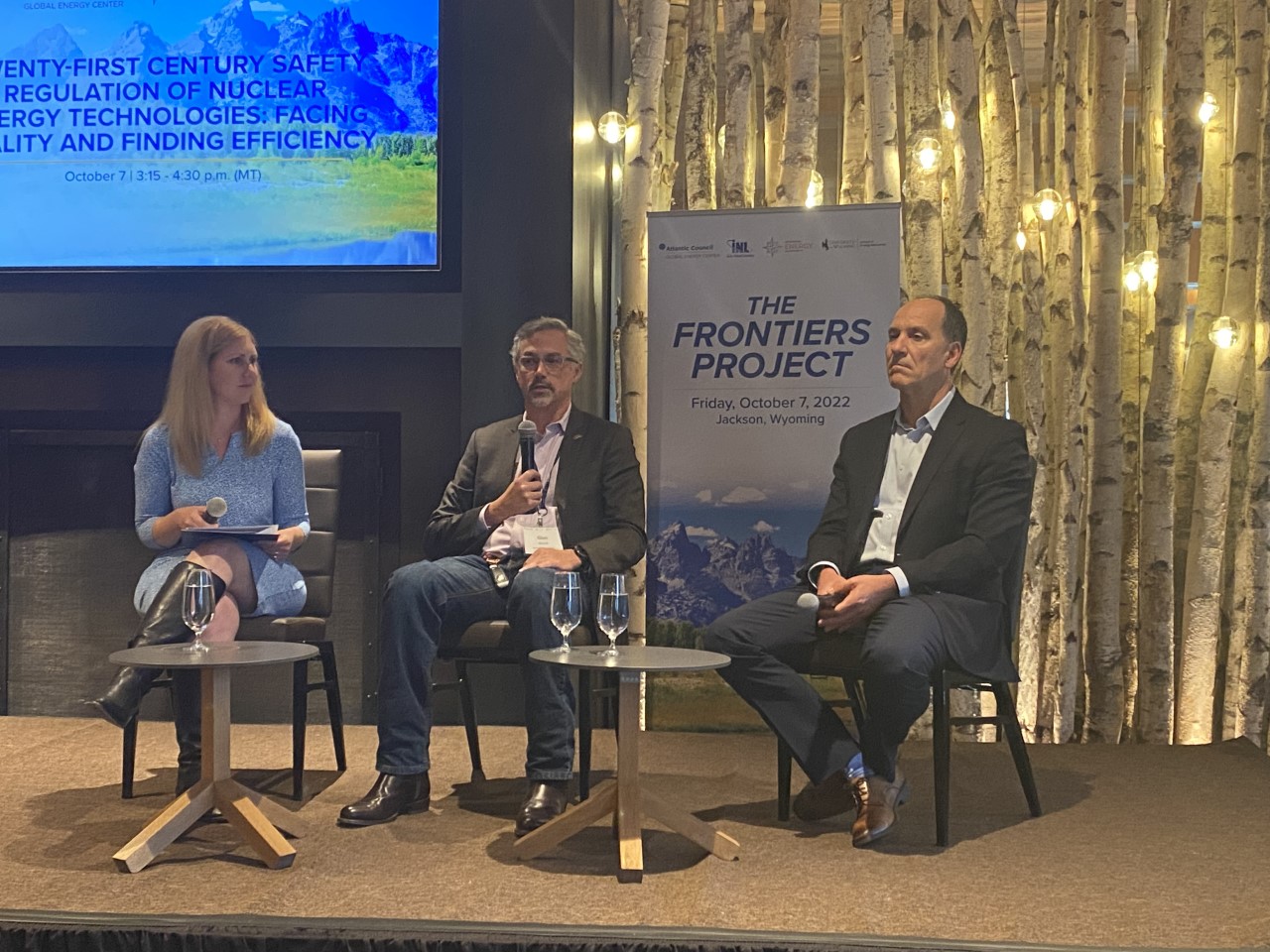Wyoming’s embrace of advanced energy and manufacturing technologies has positioned the state to become a trailblazer in the global low-emissions economy.
Wyoming’s leadership in the nation’s energy future was the topic of this year’s Frontiers Project Meeting Oct. 7 in Jackson, Wyoming. The meeting brought Wyoming officials and entrepreneurs together with some of North America’s leading experts in energy, manufacturing, finance and technology. The event was hosted by the Wyoming Energy Authority, Wyoming Business Council, the University of Wyoming School of Energy Resources and the Atlantic Council.
The meeting comes as the state welcomes next-generation nuclear energy technologies. In late 2021, TerraPower selected Kemmerer, Wyoming, as the location for its Natrium Power Plant.
The announcement has served as a catalyst for discussions and action between researchers at Idaho National Laboratory — the nation’s premier research center for nuclear energy research and development — and Wyoming’s elected officials, state agencies and business leaders.
In May, Glen Murrell, Wyoming Energy Authority director, and John Wagner, Idaho National Laboratory director, signed a memorandum of understanding agreeing to collaborate on the research, development, demonstration and deployment of advanced nuclear energy technologies. Those technologies include innovations that harness nuclear energy for industry applications.
A high energy IQ
At the Oct. 7 meeting, Murrell highlighted Wyoming’s high energy IQ: The state has a small population, forward-thinking leadership and well-developed energy, mining and manufacturing sectors, all of which make it well suited for advanced energy solutions. “Wyoming is absolutely at the frontier,” he said. “You want to choose the place where your risk is the least. You choose Wyoming, and you’ve got a really solid foundation to build on.”
Through forums like the Frontiers Project Meeting, INL is helping states like Wyoming and Alaska explore how advanced technologies like microreactors could give the state an advantage in a global economy where emission-free energy and manufacturing are poised to play a dominant role.
The laboratory’s role is to perform the research, development and demonstration necessary to ultimately support the deployment of new nuclear systems that are cost effective, secure, reliable and resilient, Wagner said. Providing stakeholders with the informed advice on how to leverage those systems is a key part of that mission.

That work includes looking at applications for nuclear energy beyond electricity, especially to power energy-intense industries such as chemicals, which are vital for any number of industrial processes in Wyoming and around the world.
As soon Terrapower began discussing the possibility of coming to Wyoming, the state’s business leaders and elected officials contacted INL. “They reached out with intention about what they wanted to accomplish and where they needed help,” Wagner said.
Global trends toward emission-free technologies
At the meeting, representatives from several venture capital firms said their companies have identified global trends and are tailoring their investment strategies in anticipation of the transition to emission-free technologies.
“Looking into the future, it became clear that capital markets are making this clean energy decision for people,” said Steven Aumeier, senior advisor for strategic programs at INL and one of the event’s organizers. “Because of that shift to low emissions activity, whole industrial sectors and economies will be reshaped. This will have profound impacts on national security and economic competitiveness.”
States such as Wyoming and Alaska with high energy IQs are nimble enough to take advantage of the global transition to emission-free technologies.
In the past, economies like those in Wyoming and Alaska have relied heavily on extracting natural resources and shipping them to other states where they are turned into high-value products.
In the future, high-temperature heat and hydrogen produced by advanced nuclear reactors could help develop manufacturing sectors that would add value to those natural resources, creating wealth that stays within the state.
More advantages for industry
Emission-free heat isn’t the only advantage that nuclear power could provide for advanced manufacturing companies in Wyoming.
Manufacturing companies are especially dependent on clean, reliable power to run operations, and future electricity demand in the U.S. is expected to skyrocket, said Mike Wandler, president of L&H Industrial in Green River, Wyoming. “I think the problem is we need more power… and nuclear is the most interesting,” he said. “It’s an opportunity to fix the problem before it becomes the problem.”
The second opportunity is to provide goods and services for the burgeoning, global advanced nuclear energy industry, said Chris Levesque, president and CEO of TerraPower.
“The first Natrium plants are going to be in Wyoming and maybe Utah,” he said. “Then, we’ll go to other countries. If a local manufacturing company did a good job on the first [Natrium plant], guess what? They’re going to come with us.”
Wyoming also happens to have abundant uranium deposits, making the state a good candidate for taking ownership of the global supply chain for nuclear fuel.
Genesis Alkali — a trona mining company based out of Green River — is taking a hard look at advanced nuclear power to provide electricity and heat for its mining operations. Nuclear energy could allow the company to upgrade trona to valuable products such as glass, said Fred von Ahrens, Genesis Alkali’s vice president of manufacturing.
“We’re working on building out that infrastructure to reliably and economically reduce our carbon footprint and reach net-zero while still making money,” he said.
Likewise, Dow Chemical has entered into an agreement with U.S. reactor developer X-energy to use X-energy’s Xe-100 reactor to power one of Dow’s facilities on the U.S. Gulf Coast, said Michelle Noack, global climate transition director for Dow Chemical. Both Noack and von Ahrens made their comments Oct. 6 at the 2022 Wyoming Global Technology Summit, an annual event held each fall in Jackson, Wyoming.
“We are huge energy consumers,” Noack said, explaining that the company plans to eliminate or offset its carbon emissions by 2050. “We recognize that we have a responsibility to reduce emissions. We think that nuclear is absolutely part of the solution.”
In the end, the global shift to low-emissions energy and manufacturing provides a relatively small, wealthy industrial state like Wyoming with an opportunity to capture a leadership role.
“Frontiers are dangerous,” Aumeier said. “You better navigate them right, but they’re also where fortunes are established.”







